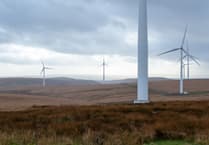Manx Utilities’ proposal to build a wind farm on the island could cost around £40m.
Delivering at least 20MW of electricity from renewable sources is part of the ‘Island Plan’ and the government committed to an onshore wind project earlier this year.
Figures have been released as part of the Operational Decision Making document dated July 4, before Tynwald agreed to further exploring options.
Two sites have been identified that could house the island’s first windfarm, Earystane and Scards to the south and Sulby and Druidale to the north.
There are a number of factors that go into the potential cost of the schemes, including how many wind turbines are needed.
The report says: ‘The lowest cost option is the installation of 5 x 4.2MW turbines at Earystane and Scards.
‘On this basis the project would also deliver a lower cost to customers in terms of a future generation tariff in p/kWh.
‘Broadly this is because the cost of infrastructure is lower and the larger wind turbine sizes are utilised.’
It adds: ‘Despite this additional large infrastructure cost, it is still a more cost effective option than either of the Sulby and Druidale options.’
If Manx Utilities was to go with 5MW turbines at the southern site, then it would be necessary to build a landing stage at Castletown Beach which would ‘need to remain in place for the full life-span of the windfarm and would likely have a high environmental impact if required’.
The report says that this would increase the cost of the Earystane site to that of the Sulby site, which is given the ‘rough cost’ of £40m.
Sulby and Druidale had a higher price tag attached to it than the southern site due to the additional turbines that would be needed.
The MUA report adds: ‘Some members of the ODM Team were willing to make the decisions on cost alone. However, it was noted that there were unknown costs in mitigating additional unknown ecological risks and the majority of team members did not support this action at this stage.
‘It was discussed that the lower visual impact of Sulby & Druidale was less likely to attract objections and the additional cost may be worth offsetting this risk.
‘It was reiterated that the team were asked to make a decision on the overall best technical and environmental option, rather than the option with the lowest cost.’




